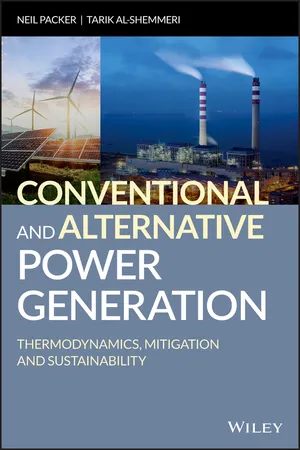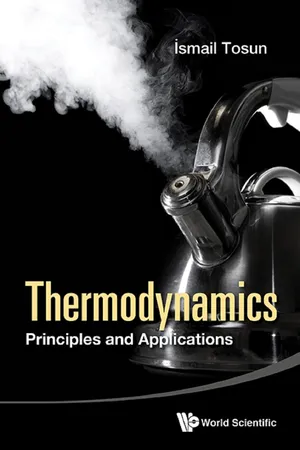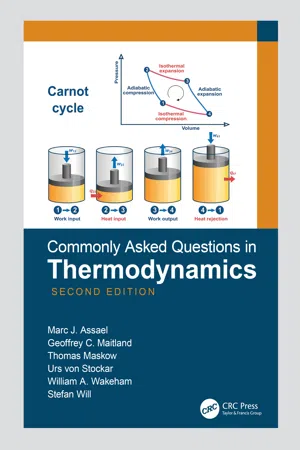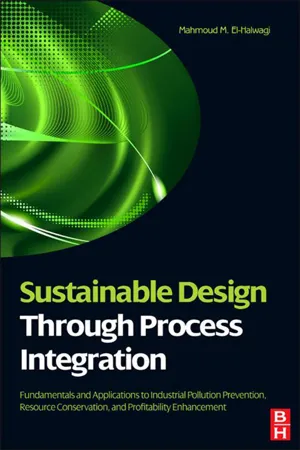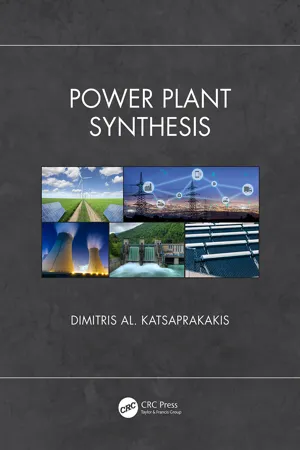Technology & Engineering
Power Cycle
A power cycle refers to the thermodynamic process that converts heat into mechanical work or electricity. It typically involves a fluid, such as water or steam, undergoing various stages of compression, heating, expansion, and cooling to produce power. Power cycles are fundamental to the operation of various energy conversion systems, including steam turbines, gas turbines, and internal combustion engines.
Written by Perlego with AI-assistance
Related key terms
7 Key excerpts on "Power Cycle"
- eBook - ePub
Conventional and Alternative Power Generation
Thermodynamics, Mitigation and Sustainability
- Neil Packer, Tarik Al-Shemmeri(Authors)
- 2018(Publication Date)
- Wiley(Publisher)
2 Vapour Power Cycles2.1 Overview
The majority of power stations rely on phase changes in a working fluid such as water to provide power. Thermodynamic analyses such as the Carnot cycle and the Rankine cycle are employed in order to calculate the power output and efficiency of thermal conversion. This chapter will introduce the basic Power Cycles and examine enhancements that increase overall efficiency.Learning Outcomes
- To understand the basic vapour cycles and demonstrate the limitation of the hypothetical Carnot cycle.
- To understand the practical amendments used to improve steam cycle efficiency.
- To understand the concept of the Organic Rankine cycle.
- To be able to appraise combined heat and power (CHP), trigeneration and quad generation.
- To be able to solve problems related to steam cycles.
2.2 Steam Power Plants
A power plant is an installation for the production of electrical energy. A steam power plant utilizes the heat released during the combustion of fuel to heat water flowing inside tubes, thus transforming it into steam, which is subsequently allowed to expand in a turbine unit especially designed with rows of blades absorbing the energy of the steam. The mechanical (rotational) energy of the turbine is converted into electrical energy by the generator that is mounted on the same shaft as the turbine unit. A typical steam power plant is shown in Figure 2.1 - eBook - ePub
Thermodynamics
Principles and Applications
- İsmail Tosun(Author)
- 2015(Publication Date)
- WSPC(Publisher)
Chapter 6Power and Refrigeration Cycles
Thermodynamic cycles are broadly classified as power and refrigeration cycles. A Power Cycle (or heat engine) generates work using an energy source at a high temperature while a refrigeration cycle (or heat pump) provides cooling from a work input.Power Cycles are divided into two categories: vapor Power Cycles in which the working fluid is alternately vaporized and condensed, and gas Power Cycles in which the working fluid remains in the gas phase throughout the entire cycle.Like Power Cycles, refrigeration cycles can be divided into two categories depending on the type of working fluid, known as the refrigerant : vaporcompression refrigeration cycles in which the refrigerant is alternately vaporized and condensed, and gas compression refrigeration cycles in which the refrigerant remains in the gas phase throughout the entire cycle.The purpose of this chapter is to provide the basic principles for the analysis of power and refrigeration cycles. 6.1Vapor Power CyclesIn vapor Power Cycles, the selection of a working fluid is dependent on various factors, such as physical properties, availability and cost, stability, safety and compatibility, and effect on the environment. Steam, by far, is the most commonly used working fluid. For low temperature heat sources, such as geothermal and solar, low boiling organic fluids are preferred1A typical vapor Power Cycle is the steam power plant shown in Fig. 6.1. Today, much of the electricity used in the world is produced in steam power plants consisting of four major components: boiler (or steam generator), turbine, condenser, and pump.Fig. 6.1 A typical steam power plant.In the boiler, different energy resources, such as fossil fuels (coal2 - eBook - ePub
Thermal Power Plant
Design and Operation
- Dipak Sarkar(Author)
- 2015(Publication Date)
- Elsevier(Publisher)
Rankine cycle .A thermodynamic cycle is ideally be made up of any three or more thermodynamic processes as follows:i. Isothermal (constant temperature) process ii. Isobaric (constant pressure) process iii. Isochoric (constant volume) process iv. Adiabatic (no heat is added or removed from the working fluid) process v. Isentropic or reversible adiabatic (no heat is added or removed from the working fluid and the entropy is constant) process vi. Isenthalpic (constant enthalpy) processTable 1.1 shows some examples of thermodynamic cycles.Table 1.1 Example of thermodynamic cyclesCycle/Process Compression Heat addition Expansion Heat rejection External combustion Power Cycles: Carnot isentropic isothermal isentropic isothermal Stirling isothermal isochoric isothermal isochoric Ericsson isothermal isobaric isothermal isobaric Internal combustion Power Cycles: Otto (Gasoline/Petrol) adiabatic isochoric adiabatic isochoric Diesel adiabatic isobaric adiabatic isochoric Brayton adiabatic isobaric adiabatic isobaric (Note: Details on internal combustion Power Cycles can be found in Chapters 7 and 8 .)In a simple steam power plant as the fluid circulates it passes through a continuous series of cyclic mechanical and thermodynamic states. Water enters a steam generator at a certain pressure and temperature and gets converted to steam, the high-pressure steam then enters a steam turbine and expands to a low pressure while passing through the turbine, the low pressure steam then gets condensed in a condenser, and the condensed water is recycled back to the boiler at original pressure and temperature (Figure 1.3 ) [6 ,7] - eBook - ePub
- Marc J. Assael, Geoffrey C. Maitland, Thomas Maskow, Urs von Stockar, William A. Wakeham, Stefan Will(Authors)
- 2022(Publication Date)
- CRC Press(Publisher)
Figure 6.2 .The Power Cycle illustrated in Figure 6.2 includes the following steps:Figure 6.2Typical scheme of a basic, idealized Power Cycle: The cycle consists of a series of steps where only work or heat are transferred, respectively.- step 1–2: Work input as ws12 (increasing system pressure)
- step 2–3: Heat input as q23 (heat provided)
- step 3–4: Work output as ws34 (that is to be maximized)
- step 4–1: Heat rejected as q41 (waste heat)
(6.9)w s=w s12+w s34,where ws12 > 0, ws34 < 0 and ws < 0 and |ws | is to be maximized.Before turning to some specific processes in the questions following this, we examine some generic and characteristic features of processes by reference to an example four-step process. However, there is no requirement for exactly these four steps to occur, and in an actual process there are often many more than four.We begin by examining two characteristic diagrams: (p, v) and (T, s). For simplicity, we assume that all process steps are reversible, a restriction that if lifted does not alter the conclusions reached.Figure 6.3 shows both a (p, v) and a (T, s) diagram. Figure 6.3a illustrates the shaft work, which is the central quantity of a Power Cycle, given by (cf. Question 1.3.6)Figure 6.3A Power Cycle: (a) (p, v) diagram and (b) a (T, s) diagram. For a reversible process, the area enclosed by the cycle represents the net work output; (b) depicts a Carnot cycle, where heat is provided at constant temperature T, and rejected at constant temperature T0 - eBook - ePub
Sustainable Design Through Process Integration
Fundamentals and Applications to Industrial Pollution Prevention, Resource Conservation, and Profitability Enhancement
- Mahmoud M. El-Halwagi(Author)
- 2011(Publication Date)
- Butterworth-Heinemann(Publisher)
The objective of this chapter is to present the principal aspects of energy integration with focus on the integrated design of heat and power systems.This chapter presents the principal aspects of energy integration with focus on the integrated design of heat and power systems, commonly referred to as combined heat and power (CHP). The integration of thermal energy through the synthesis of heat-exchange networks (HENs) is a key element of an effective energy-management strategy. In addition to heating and cooling, other forms of energy should also be considered through the concept of energy integration. The concepts of heat engines and heat pumps are discussed along with key thermodynamic cycles integrated with the thermal pinch analysis. Design rules are given for the placement of heat pumps and heat engines. Heat engines are devices that use energy in the form of heat to provide work. They are the basis for many cyclic processes that are used in industry and they have a strong interaction with the heat integration of the processes. A common application is the automobile engine where heat is generated during one part of the cycle and is used in another part of the cycle to produce useful work. A heat pump is a device that uses external energy in the form of external work to extract heat from a low-temperature heat source to a high-temperature heat sink. Consequently, a heat pump conceptually operates opposite to a heat engine as it uses work to force the flow of heat from low to high temperature. It is widely used in many applications such as the refrigeration where heat is extracted from a low-temperature source by exerting external work on the system. The concept of combined heat and power (CHP) can be further extended to combined cooling, heating, and power (CCHP), which is commonly referred to as trigeneration.Key thermodynamic cycles are described and integrated with the thermal pinch analysis. Then, design rules are given for the placement of heat engines and heat pumps, devices that use external energy in the form of external work to extract heat from a low-temperature heat source to a high-temperature heat sink. Next, a systematic approach is given for the targeting of cogeneration systems dispensing process heating and power.The chapter discusses the Carnot cycle and the Rankine cycle, heat engine cycles. It also addresses approximate correlations to predict steam table values for conceptual design and targeting, cogeneration targeting, when the process requirements are in the form of heating demands, and extractable energy, which is based on the header levels that the turbine actually operates between. - eBook - ePub
- Irving Granet, Jorge Alvarado, Maurice Bluestein(Authors)
- 2020(Publication Date)
- CRC Press(Publisher)
Cogeneration has recently become a feasible method of energy utilization. By the simple expediency of using the low-temperature energy for process or heating requirements, it is possible to combine electrical energy generation with heat requirements to obtain greater energy utilization than when each requirement is performed separately. While cogeneration does not introduce any new concepts, the savings in energy can be considerable. Most of the equipment needed to implement cogeneration can be obtained as standard “off-the-shelf” items.Key Terms
Terms used for the first time in this chapter are as follows:- Cogeneration: The simultaneous generation of power and heating or process steam to increase the overall utilization of energy.
- Direct energy conversion: The conversion of a fuel or energy source directly to electrical energy without the use of a circulating fluid or any moving parts.
- Fuel cell: An electrochemical device in which the fuel and the oxidant are consumed to produce a voltage across an electrical load.
- Geothermal energy: The energy stored in the earth’s crust.
- Rankine cycle: A vapor cycle consisting of four processes: a constant-pressure vaporization, an isentropic expansion, a constant-pressure condensation, and a return to the initial conditions of the cycle.
- Regenerative cycle: A cycle in which the condensate from the condenser is ideally continuously heated by an interchange with the steam as it expands in the turbine before it is returned to the boiler.
- Reheat cycle: A Rankine cycle in which the steam is expanded in a turbine to an intermediate pressure, is returned to the steam generator, and then returned to the turbine to expand to condenser pressure.
- Solar energy conversion: The use of a photovoltaic device to convert incident solar energy directly to electricity.
- Thermionic converter:
- eBook - ePub
- Dimitris Al. Katsaprakakis(Author)
- 2020(Publication Date)
- CRC Press(Publisher)
Chapter 2 . Combined cycles are introduced in conventional electricity production thermal power plants aiming at the increase of the efficiency of conventional gas turbines. On a theoretical basis, power production from combined cycles is analyzed in two thermodynamic cycles, connected to each other with a working medium and operating in different temperatures. Heat is released from the high-temperature cycle (top cycle) to be recovered in the low-temperature one (bottom cycle) for the production of additional electricity, increasing, thus, the total efficiency of the electricity production process.In cases of cogeneration technologies introduced in combined cycles, thermal energy can be recovered from the remaining heat in the form of low enthalpy steam after the power production in the steam turbine or by the disposed hot gases from the gas turbines, after the gas boiler. A power flow diagram and the fundamental layout of a cogeneration system with a combined cycle is presented in Figure 5.12 .Figure 5.12 Cogeneration power plant layout and power flow diagram with combined cycle.The total efficiency of the cogeneration process with a combined cycle is by far much higher than the efficiency of cogeneration systems with conventional thermal generators, reaching values from 70% to 85%. Yet, the overall efficiency is significantly affected in partial-load operation. They also exhibit higher power concentration (mechanical and thermal power output per unit of volume) compared to the other cogeneration systems with steam or gas turbines. Cogeneration systems with combined cycles are developed with nominal power around 20–400 MWe , although smaller units can also be constructed (from 4 to 11 MWe
Index pages curate the most relevant extracts from our library of academic textbooks. They’ve been created using an in-house natural language model (NLM), each adding context and meaning to key research topics.
